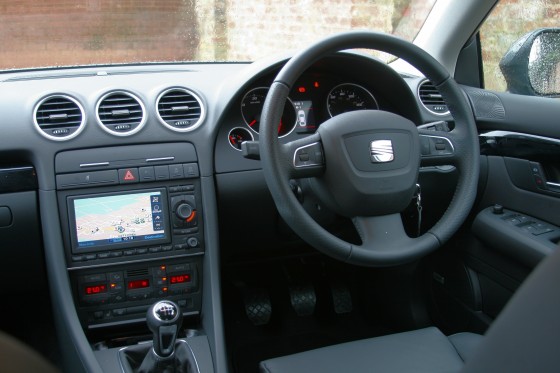As I write about the SEAT Exeo Sport Tech I do so in the knowledge that its days are numbered. SEAT have decided that the Exeo will be taken off the market later this year and it won’t be replaced.
What should have been a review finds itself turning into more of an obituary. Should we mourn the loss of this saloon or should we let it pass peacefully, give it a couple of days and then move on with our lives?

SEAT Exeo Sport Tech Review (2013)
What Model Is This?
This is the Exeo Sport Tech, which sits at the top of the range above the S and SE. The ‘Tech’ part of the name tells you that this has a number of useful extras on top of the usual Sport goodies, including black leather upholstery, Bose stereo upgrade with iPod connection and 2 SD card slots, and sat-nav with 6.5-inch colour screen built into the centre console.
That’s on top of the bi-xenon headlights with cornering function and built-in LED running lights, LED lighting at the rear, dual-zone climate control, 6 airbags, multi-function computer with colour screen, auto lights and wipers and cruise control.
The Sport model would usually ride on 18-inch ‘Quartz’ wheels but this is an Ecomotive model so that means you get smaller 16-inch ‘Morfeo’ wheels for improved economy.Shame, as the 18s are much nicer.

Ecomotive rides on 16s, not 18s like other Sport models
What’s Under The Bonnet?
You can specify the Exeo with a 211PS 2.0 TSI petrol or a selection of 2.0-litre diesels. This particular one has the 143PS Ecomotive TDI, a common-rail diesel that comes with stop/start technology to squeeze a few extra miles out of each gallon. With an official combined figure of 62.8mpg and CO2 emissions of just 117g/km this is a car that will be cheap to run and slots into Band C on the VED scales.
It Looks Familiar. Very Familiar.
It’s difficult to talk about the Exeo without the subject of its parentage coming up. Can you remember the previous generation Audi A4 (the ‘B6/B7’ model built between 2001 and 2008)? Smart, wasn’t it? Highly regarded too. Now stick a SEAT badge on it, add those Audi-esque headlights complete with LED strips and hey presto, you’ve got the Exeo.

Exeo’s side profile is very familiar and nicely proportioned
The underpinnings of the Exeo are so closely related to the A4 that SEAT actually went as far as dismantling the entire Audi A4 B7 production line in Ingolstadt and re-assembled it at their factory in Martorell, Spain.
Should the Exeo be derided because it’s based on Audi’s cast-offs or should we applaud it for recycling what was a very good car but with a new design, new engine technology and some Germanic design touches? Personally I’ll go for the latter, not least because it’s a bit of a bargain.
This Exeo will set you back £24,595, including the Ice Silver metallic paint at £495. If you were to price up an Audi A4 with the same engine and equipment as this Sport Tech it would cost you in excess of £32,000. Yes, the interior will be a bit more plush and the on-board computer will be more advanced but really, is that worth an extra £7,000?
What’s It Like To Drive?
Don’t let the ‘Sport’ badge fool you, this Exeo is more of a cruiser than a precision implement with which to dissect your favourite road. The suspension setup is soft enough to be comfortable but not so soft that the Exeo turns into a wallowy barge through the bends.

Nose looks good but plays too big a role in Exeo’s balance
Drive it with gusto and it won’t give you much back in the way of reward. The balance is very much biased towards the front, with the heavy nose inducing understeer as soon as you start to push on. The multi-link fully independent front and rear suspension might lead you to think this could be a sports saloon but the handling is best described as tidy rather than sharp. At least the Exeo is predictable and won’t spring any nasty surprises on you if you do find yourself running out of grip.
The diesel engine is a typical VAG group unit with that familiar punchy mid-range that’s easy to exploit via the six-speed manual gearbox. It runs out of puff above 3,000rpm and gets a bit vocal when you really push it, but the ‘Ecomotive’ badge doesn’t mean you’re lumbered with a sluggish engine.
It is also very economical if you drive it sensibly and I was easily able to match the official economy figures on a couple of trips. My overall average for the week was a respectable 56mpg over 350 miles, not bad when you consider this is a 1,505kg family saloon.
What’s It Like To Live With?
The Exeo is classed as a medium/large saloon and it lives up to that label. The cabin offers its occupants plenty of room with no elbow rubbing up front and enough head and leg room in the back for all but the tallest of adults. It’s not the most exciting of places to sit but everything feels like it is built to last.

You’ll find all of the toys you need on the Exeo’s dashboard.
The upgraded Bose stereo system is very good. The eight speakers provide loud and clear tunes and the SD card slots are great for loading up with MP3 files.
I should also mention the heated seats. They’re some of the best I’ve tried, beating even Volvo’s fantastic seats for sheer buttock-toasting power. The heating is included with the optional winter pack but on a freezing winter morning you’ll appreciate the cosy warmth they generate.
Six airbags, ESP and traction control also make the Exeo a safe option and Euro NCAP rated it as a four-star car in 2010.
What’s Wrong With It?
The biggest problem I found is that the multimedia and sat-nav systems, unique to the Exeo, are far from intuitive. The screen and menu navigation required a bit of trial and error to find the option you wanted and it was difficult to use while driving. The interface just requires a bit more thought and I know SEAT can do better as the multimedia system fitted to the Leon FR+ I drove last year was far superior. Fewer buttons, better menus, easier to use.
I also found the sat-nav screen to be mounted too low, requiring me to take my eyes off the road for longer than necessary to view the information on the screen.
The lack of a DAB radio, even as an option, is one glaring omission from an otherwise generous specification. With digital on the rise and the analogue radio signal likely to be switched off in the next couple of years it won’t be long before you’d be looking to replace the radio.
The Final Reckoning
For the Exeo to be dropped after only four years is a shame. It might not have the sophisticated underpinnings of some of the newer members of the VAG group but it still manages to be a decent car, and certainly one of the best value models offered by the VAG group.
Its biggest problem seems to be that it is one of those cars that has completely escaped the attention of potential buyers. I was genuinely surprised by the number of blank looks I received when I told people what I was driving. I wonder if the similarities to the A4 have worked against it, with people mistaking the Exeo for an A4 when they see one on the road. If the Exeo had more of an identity of its own, rather than borrowing so much from its German relation, maybe it would have stood out more. What it really needed was a sporty FR model or even a Cupra to spice up the range.
So farewell, dear Exeo. It was nice to have the opportunity to try it but I don’t think it’s a car that’s going to be sorely missed when its gone. Not because it was a bad car, but because it never made enough of an impression for people to notice its absence.
SEAT Exeo Sport Tech Ecomotive Scores
| PERFORMANCE | Perky diesel engine | 7 |
| HANDLING | More of a cruiser than a B-road blaster | 6 |
| AFFORDABILITY | Exeo is good value and will be cheap to run too | 8 |
| DESIRABILITY | Looks like an Audi to the untrained eye | 7 |
| DRIVING SPIRIT | It’s a very sensible choice but not a fun one | 6 |
| Overall Rating | 6.8/10 |
SEAT Exeo Sport Tech Ecomotive Specifiations
| Engine: | 1,968 cc 4-cylinder turbocharged diesel |
| Power: | 140 bhp |
| Torque: | 236 lb/ft |
| 0-62 mph: | 9.2 seconds |
| Top Speed: | 134 mph |
| Weight: | 1,505 kg |
| CO2 Emissions: | 117 g/km (Band C) |
| Official Economy: | 62.8 mpg |
| Insurance Group: | 24 |
| Price (OTR): | £24,120* |
| Price (As Tested): | £24,890* |
*Prices taken from SEAT website, April 2013





